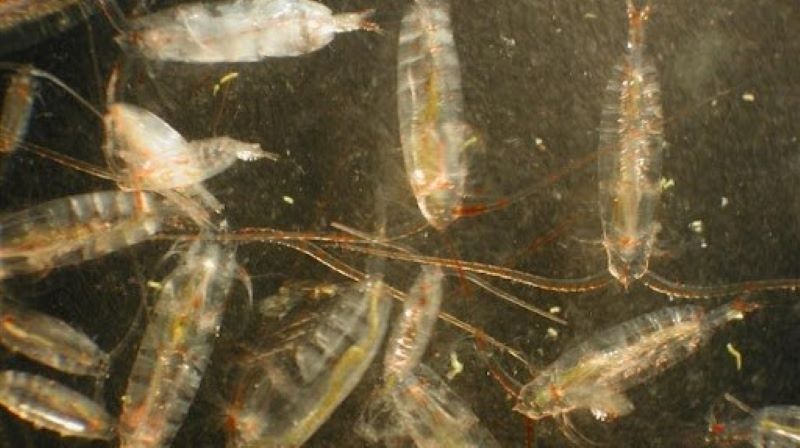What is vertical migration of zooplankton and why does it matter?
As the greatest migration on Earth, the daily vertical movement of zooplankton in the ocean has a massive influence on sea life and the global climate.

This echogram illustrates the ascending and descending phases of the diel vertical migration through the water column. The yellows and reds are indicative of the greatest density of animals. Image courtesy of DEEP SEARCH - BOEM, USGS, NOAA. Download largest version (jpg, 365 KB).
Every day, billions and billions of animals, mostly zooplankton (e.g., smallish animals, including fish, various shrimp, and jellies), migrate up and down in the ocean all over the planet. That’s a lot of movement. Scientists call it diel vertical migration, or DVM for short. But why does it happen? And how does all that movement of organisms impact our ocean ecosystem and other fundamental systems of planet Earth?
Daily migrations of aquatic animals were first noted by the great French naturalist Georges Cuvier in the early 1800s, and over the years numerous scientists have been curious about this phenomenon. And that curiosity has been turned into lots of natural history knowledge related to how and why DVM happens.
Some human behaviors and processes, like sleep, happen at a specific time of day/night. They follow a circadian rhythm that has been associated with genetics. Scientists have found that the same is true for DVM. However, external cues – primarily light or irradiance, but also temperature, prey abundance, or predation risk – also affect the scale and scope of DVM behaviors.
All this movement consumes a great deal of energy, prompting various hypotheses to explain why it’s worth it. For many animals, the best explanation is that they swim up to food-rich surface waters at night to feed when light is scarce and they are “hidden” from predators that rely on light to sense their prey. The migrators then return to the depths before the sun rises. Animals may also migrate to reduce ultraviolet damage to their DNA, to use the currents to move to areas with more food, or to take advantage of the benefits of colder (deeper) waters to grow larger or produce more eggs.

Copepods (shown here) are a type of zooplankton and are a big part of the diel vertical migration. Like other tiny marine animals that share a similar diet, copepods are particularly likely to migrate to surface waters at night and deep water during the day. Image courtesy of NOAA Fisheries Alaska Fisheries Science Center. Download largest version (jpg, 74 KB).
This greatest migration on Earth has big impacts on ocean and planetary systems. For example, when algae-eating organisms leave shallower waters during the day, primary producers (i.e., organisms that convert sunlight to food, the base of the food chain) are able to multiply with less predation pressure. Moreover, the scale of migration can be so large that it creates turbulence in the water. It can even move water as demonstrated in one study that showed that vertically migrating jellyfish can move water through the water column. This water movement likely carries nutrients and particles across water boundaries to places they wouldn’t otherwise be found.
Finally, DVM plays a major role in the carbon cycle. As animals return to the deep after feeding at the surface, their waste speeds up the rate at which carbon is transported to the ocean floor (a process known as carbon sequestration). During this time of global climate change, this means that shifts in the intensity of DVM behaviors could impact the carbon cycle. We still only know a little about how this phenomenon in different parts of the world is responding to climate change, so this is an important avenue for future research.
Published October 28, 2021
Last updated August 21, 2024
Contributed by: Allen Collins, NOAA Fisheries National Systematic Laboratory and Smithsonian National Museum of Natural History
Relevant Expedition: Windows to the Deep 2021